Analysis on China PX imports in terms of origins
According to China customs data, as of May, the country imported 5.028 million tons of PX in the first five months of 2022, down 11.9% from the same period of last year. The imports reached 823kt in May, down 20.7% on year and down 9.6% from a month earlier.
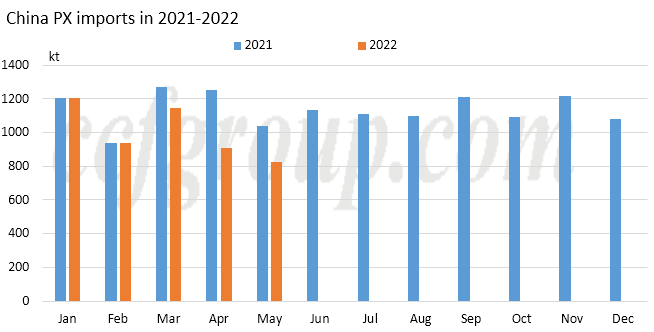
South Korea, Brunei and Japan, as the main origins, contributed more than 70% of the total imports in Jan-May. However, due to China’s fast capacity expansion in recent years, the imports showed a decreasing trend in the first half of 2022. PX imports were little changed from the same period of last year in Jan and Feb, but reduced notably on year in Mar-May. In May, the imports decreased by a whopping 31.4% from Jan 2022.
Self-sufficiency rate increases
China and Asian PX plant operating rate ticked up obviously in the beginning of 2022. The industry chain was strong and PTA plant operating rate began rising in Jan, therefore, China PX operating rate hiked in tandem and exceeded the operating rate of PTA plants. In the meantime, China PX plant operating rate has been higher than Asian average, reflecting to some extent that China PX production is ensured with slightly reduced demand for imported PX.

Imports from main origins
The figure below shows the percentages of PX imports from each country or region.
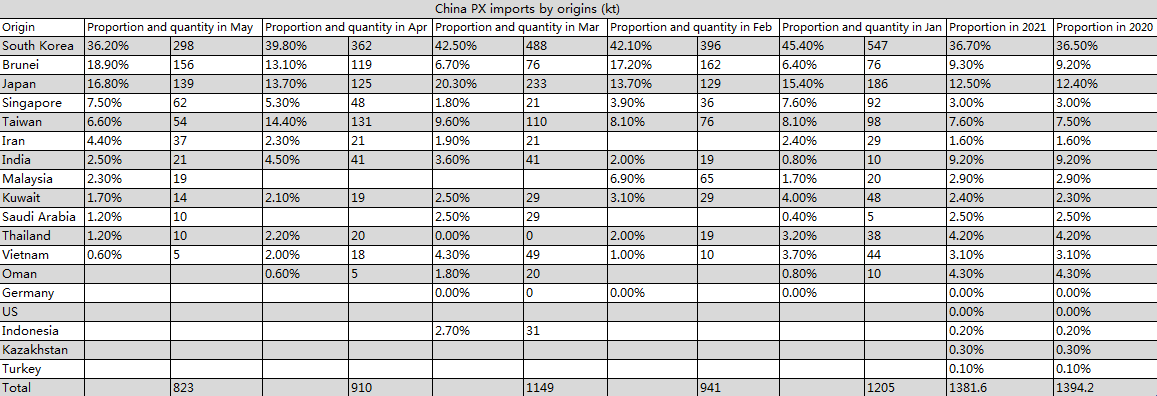
In the first five months of 2022, South Korea, as the largest origin for China PX imports, contributed 2.091 million tons of PX to China. Japan came second with 812kt and Brunei as the third with 589kt of PX to China, though Brunei took up higher proportions than Japan in Feb and May.
The percentage of China PX imports from South Korea dropped from 45.4% in Jan to 36.2% in May 2022. The volume of imports from South Korea also decreased by 195kt on year in Jan-May.
In terms of South Korea’s PX exports, the monthly export volume decreased by 178kt or 30% from Jan to May, and percentage of exports to China also declined from 89% in Jan to 69% in May. The shrinking proportion that China accounted for was because that South Korea increased the export to US and Brazil in Apr and May. South Korea did not export any PX to US or Brazil in Jan-Mar, but the percentage of exports to those two countries reached 8% in Apr and 12% in May. As the Asia to US arbitrage open, materials flowed to US and hence PX price was driven up in May.
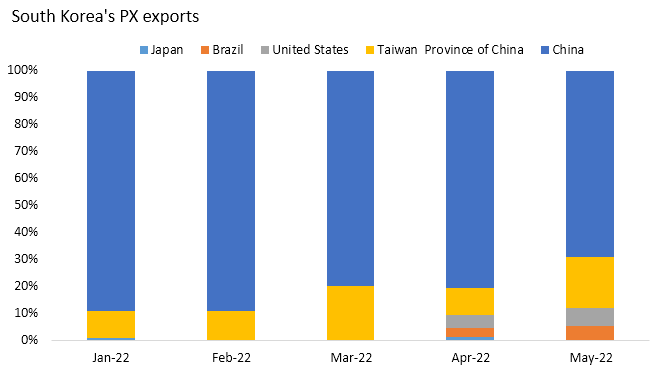
South Korea’s PX exports decreased, but its production did not and the average plant operating rate had ticked up from 79% to 82% in early Feb. It seems that South Korea is likely to stock up materials and then export via big ships to reduce the frequency, or domestic suppliers were increasing the inventory. In either case, South Korea’s PX exports could increase in later period.
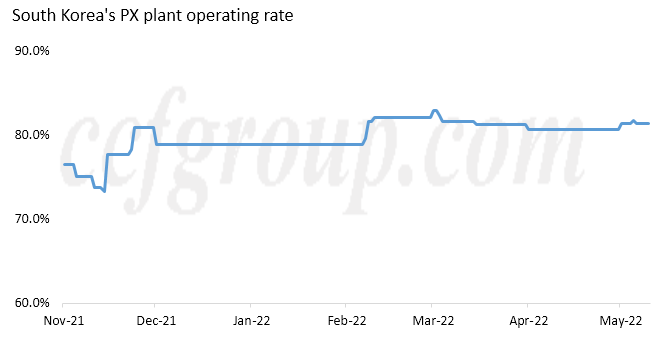
PX imports of China from Brunei reached 156kt in May, accounting for 18.9% of total. Hengyi Brunei’s 1.5 million mt/yr PX plant has been keeping normal operation for much of the time since the startup in 2019. Its products are all earmarked for China. Therefore, with the reducing PX imports of China, Brunei’s proportion has increased, while the volume from Brunei was little changed.
China PX imports from Oman decreased from 590kt in 2021 to almost zero in the first half of 2022, as Oman Aromatics’ PX plant was shut on H2 2022 and the restart date was undecided.
As for Taiwan, its net imports of PX increased, reflecting higher local demand for PX. In addition, Taiwan’s FCFC shut its PX plant in Apr for 50-day maintenance, and some PTA plants restarted in Feb. As a result, its exports to China reduced.
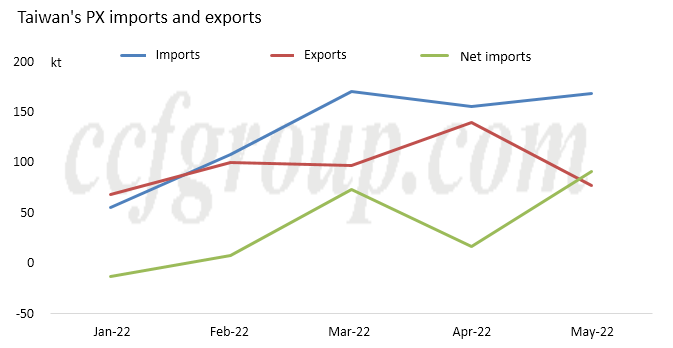
Japan’s PX exports were little changed, but the proportion of exports to China dropped notably in Feb and Apr (due to the time of shipping, there’s a discrepancy between Japan’s export data to China and China’s import data from Japan). In Feb, Japan’s PX export to Taiwan reached 59kt, up 30kt on month. In Mar, the exports to Taiwan were less than 10kt, while the proportion to China expanded. In Apr, its exports to Taiwan increased to 35kt, up 25kt on month, and some materials were exported to South Korea, squeezing the proportion to China.
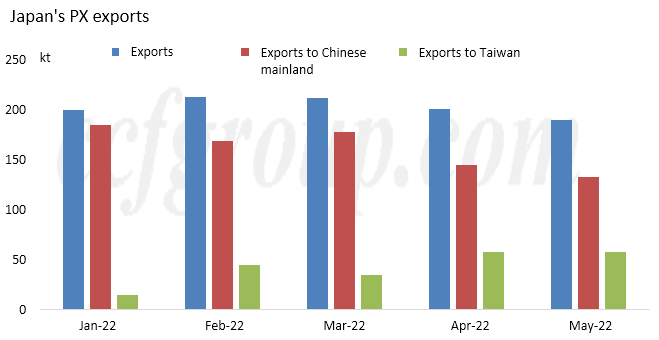
As for India, according to its customs data, China was the largest destination for India’s PX exports, receiving 1.05 million tons from India in 2021 or 85kt per month. In Jan-Apr 2022, however, the amount was only 130kt, averaging 33kt per month. India’s total PX exports reached 5.6 million tons in 2020, but slashed to 2.55 million tons in 2021. In Jan-Apr 2022, the amount further decreased to 447kt, down 292kt on year. India’s exports to Malaysia and Indonesia increased instead. Therefore, the proportion that China took was squeezed.
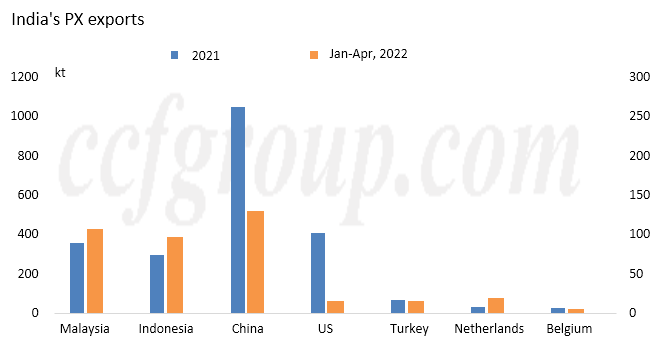
In a conclusion, South Korea’s total PX exports decreased and some materials were diverted to Americas. India’s PX exports declined due to increasing domestic demand. Japan’s and Brunei’s exports changed little, but their proportion in China’s PX imports expanded as South Korea’s proportion shrank.
- Top keywords
- Cotton Price
- Cotton Futures Price
- Cotton Futures
- CZCE
- PTA Futures Price
- Chemical Fiber
- Polyester Prices
- Wool price
- PTA Futures
- Shengze Silk
- China
- Yarn Price
- price
- China Textile City
- Fibre Price
- Benzene Price
- Cotton
- Index
- Cotton Index
- PTA
- fabric price
- NYMEX
- Top 10
- textile industry
- Spot Cotton
- Cotton Yarn
- Polyester Price
- Futures
- PTA Price
- cotton yarn price

